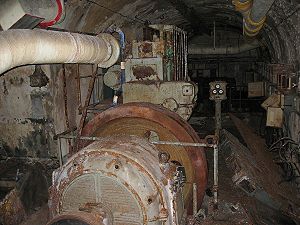Ouvrage Soetrich
| Ouvrage Soetrich | |
|---|---|
| Part of Maginot Line | |
| Northeast France | |

The usine of Soetrich, May 2004
|
|
| Coordinates | 49°25′48″N 6°10′09″E / 49.43011°N 6.16928°E |
| Site information | |
| Controlled by | France |
| Open to the public |
No |
| Condition | Abandoned, buried |
| Site history | |
| Built by | CORF |
| Materials | Concrete, steel, deep excavation |
| Battles/wars | Battle of France, Lorraine Campaign |
| Ouvrage Soetrich | |
|---|---|
| Type of work: | Large artillery work (Gros ouvrage) |
|
sector └─sub-sector |
Fortified Sector of Thionville └─Hettange-Grande |
| Work number: | A11 |
| Constructed: | 1930-1935 |
| Regiment: | 169th Fortress Infantry Regiment + 151st Position Artillery Regiment |
| Number of blocks: | 8 |
| Strength: | 583 enlisted + 20 officers |
Ouvrage Soetrich is a gros ouvrage of the Maginot Line in northeastern France. Soetrich is located between petits ouvrages Immerhof and Bois Karre, facing the France-Luxembourg border near the town of Hettange-Grande, part of the Fortified Sector of Thionville. Compared with other gros ouvrages, Soetrich is compact in arrangement, with the entries and underground ammunition magazines and barracks in close proximity to the combat blocks, accessed through underground galleries at an average depth of 30 metres (98 ft). Its primary purpose was to cover the main road to Luxembourg, just to the west. Along with its neighbors, Ouvrage Rochonvillers and Ouvrage Molvange, Soetrich was used during the Cold War as a secure command center for NATO forces.
The Soetrich site was surveyed by CORF (Commission d'Organisation des Régions Fortifiées), the Maginot Line's design and construction agency, in 1930. Work by the contractor Degaine-Dubois began the same year, and the position became operational in 1935, at a cost of 86 million francs.
Soetrich stands just to the east of the Thionville-Luxembourg road. A military road and a 60 cm narrow-gauge railway link the entrance blocks to the rear supply areas. The railway continues through the ouvrage to the combat blocks. The combat and support areas are separated by only 125 meters (410 ft), and the total length of the main gallery is 625 meters (2,051 ft).
The ouvrage comprises two entries and six closely grouped combat blocks:
The Observatoire de la Route du Luxembourg is just to the west to the ouvrage, on the other side of the main road to Luxembourg. It was equipped with an observation cloche and a GFM cloche. Just to the south is the Abri de la Route du Luxembourg, which sheltered a section of infantry that supported the observatory and the flank of the ouvrage.
Several other casemates, observatories and infantry shelters are located around Soetrich, including
None of these are connected to the ouvrage or to each other. All were built by CORF. The Casernement de Hettange-Grande provided peacetime above-ground barracks and support services to Soetrich and other ouvrages in the area.
...
Wikipedia

